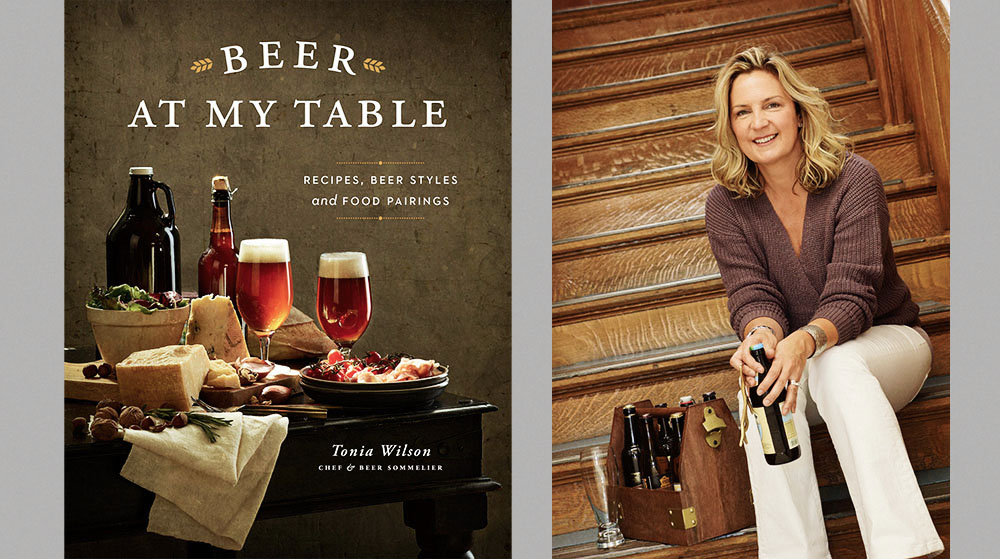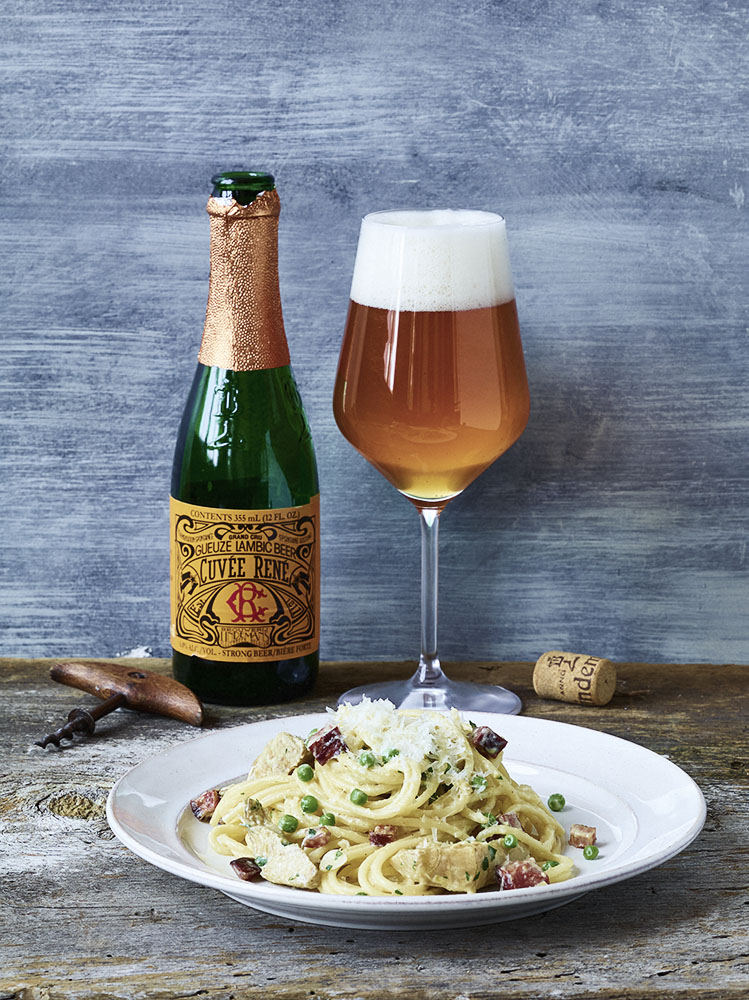Beer at My Table: Recipes, Beer Styles & Food Pairings

Avid beer fans will be happy to know that there is a book out there that dives deep into the beer and food pairing landscape to give you delicious recipes and brew suggestions. That book is Tonia Wilson’s Beer at My Table.
In 216 pages, Wilson explains what, exactly, makes a beer; gives general pairing guidelines; outlines different beer styles; walks through tasting both beer and food; and then shares her recipes that pair well with specific beers.
Not a difficult read, Beer at My Table has a more educational tone; it feels a lot like reading an informative article or a textbook. Wilson throws in technical terms here and there, which adds to the textbook-y feeling of the narrative. This isn’t one of those page turners that’ll keep you hooked all the way through. It is, however, very good at giving you all the details about beer and food you could want.
It’s touted as being a reference book for every beer lover, from the newbie to the expert, we find the informational section is more suitable for beginners than those with a long history of beer appreciation. It’s the second section – with the recipes and beer pairings – where Beer at My Table adds value for everyone.
Speaking of the recipes section. It is split into the four seasons, a great way to divide it as many people drink different styles of beer depending on the season (and cook different types of food). It is in this section that Wilson really dives into the different beer styles. The pairing beer’s profile starts each new recipes, explaining the style, when to drink it and what it’s supposed to taste like, as well as a general pairing suggestion, before listing specific beers to try. The next page has the recipe itself.
The recipes in Beer at My Table are straightforward and easy to follow. All recipes are accompanied by a photo (which also features the beer), so you have a visual guideline for what you’re making. This is a nice addition as in most cookbooks, only select recipes have photos. Visual cooks will love this.
The ingredients used in Beer at My Table aren’t too out there – pretty much any foodie or person who has been to a grocery store more than once will recognize the ingredients used. The recipes are classier than what is stereotypically known as “beer food”. These are dishes you’d see on the menu of an expensive French restaurant or ritzy, high-class bar. She’s got mussels, schnitzel, lamb meatballs, carbonara (recipe below), white fish, steak tartare – and that’s just a few of the Spring options!
Overall, Beer at My Table is an excellent reference for beer lovers, and a good “textbook” for those new to beer. It proves that beer is just as versatile as wine, pairing with more than just “pub food”. It’s worth reading through, if not for the educational aspect, then for the delicious recipes and beer pairings.
Beer at My Table / $34.60
Excerpt from Beer at My Table
 Artichoke, Pea and Lemon Carbonara
Artichoke, Pea and Lemon Carbonara
Serves 4
Use the freshest eggs you can find for this simple pasta dish so the bright yellow of the yolks adds colour to the sauce. Guanciale is Roman-style cured pork cheek; a good deli should have it.
Salt to taste
1/4 cup olive oil
2 tbsp finely chopped garlic
5 oz (150 g) guanciale or mild pancetta, chopped into 1/4-inch dice
1 1/2 cups artichoke hearts, each sliced into eight (drain and rinse if using bottled artichokes)
1 1/4 cups finely grated Pecorino Romano (about 2 1/2 oz/75 g)
2 large eggs
2 tbsp finely chopped flat-leaf parsley
2 tsp finely grated lemon zest (use a rasp for best results)
Freshly ground black pepper to taste
1 lb (500 g) good-quality dry spaghetti
3/4 cup fresh or frozen peas
Additional olive oil for drizzling
Additional finely grated Pecorino Romano for garnish (optional)
Bring a large pot of water to the boil over high heat. Add enough salt to the water so you can taste it.
Meanwhile, in a medium saucepan heat the oil over low heat. Add the garlic and cook until softened and fragrant, about 3 minutes. Add the guanciale and cook until the fat renders, about 5 minutes. Increase the heat to medium and cook until the guanciale is golden, about 5 more minutes.
If using bottled artichokes add them to the saucepan and cook for 2 minutes. If using fresh artichokes, add them to the saucepan pan along with 1/2 cup of water, then simmer, covered and flipping artichokes occasionally, until they are tender when pierced with a knife, about 20 minutes. Turn off the heat.
In a bowl large enough to hold the pasta, whisk together the cheese, eggs, parsley, lemon zest and pepper. Set aside.
Add the pasta to the boiling, salted water and cook as per package instructions. If using fresh peas, add them to the pot 3 minutes before the pasta is ready; if using frozen peas, add them to the pot 1 minute before the pasta is ready.
Meanwhile, reheat the artichoke mixture over medium heat until the cooking liquid has reduced and the artichokes are golden, about 5 minutes.
When the pasta is al dente, scoop out and reserve 1 cup of pasta cooking water from the pot, then drain the pasta. Add the pasta to the cheese mixture and toss well.
Add the artichoke mixture to the pasta and toss again until the pasta is well coated with the sauce. The sauce should not be dripping; it may take a minute of tossing and stirring until the liquid from the sauce is absorbed. Conversely, you can add a small amount of the reserved cooking water to loosen the sauce if needed.
Serve immediately, drizzling each portion with additional olive oil, and adding a scattering of black pepper and additional cheese, if desired.
Pair with a pint of Gueuze
Gueuze is a traditional Belgian beer style unique to Brussels. It is a blend of lambic beers which range in age from one to three years.
What is a lambic beer? Simply put—and, really, it’s far from simple—lambic beer is created by allowing local, indigenous yeasts and bacteria to inoculate, or attach themselves to the wort. This happens overnight while the wort is cooling in wide, shallow tanks, called coolships, that allow exposure to air. This type of uncontrolled process is called spontaneous fermentation. The wort is inoculated overnight, then goes into large barrels to await fermentation which can take a few days or even weeks to begin. Once the majority of CO2 has been released from the barrels, they are plugged (or bunged) and left to develop and age.
Wild yeasts and bacteria will slowly continue to ferment and sour the beer during this uncontrolled process which can last from one to three years. Mother Nature is doing all the work here which means each batch of beer will be different and, in a world of consistency and homogenization, this is a rare treat. One of the wild yeasts at work here is Brettanomyces, and tasting gueuze is a good way to experience the “funk” and “barnyard” qualitities that this yeast can contribute.
Lambic is a still, uncarbonated beer which gains its fine and gentle effervescence through bottle fermentation. The bottles containing a blend of lambics from one- to three-years-old are left in bottle for up to one year so they can slowly re-ferment and become effervescent before being released to the eagerly awaiting admirers of the style.
The different ages of lambic beer that go into gueuze contribute different characteristics to the finished beer. The one-year-old lambic adds brightness and residual sugar, and it is the sugar that will eventually ferment into bubbles within the bottle. The two- and three-year-old lambics, that have had time to age and sour in barrels, give complexity and depth. The different lambics are added in specific proportions by a skilled blender who creates the gueuze to be representative of the brewery’s style.
Gueuze is something of an acquired taste. I have poured it for people who have been wildly shocked that it tastes so different from other beers. But that is the beauty of this beer. It is exceptionally interesting and offers an opportunity to taste history and get a sense of the terroir of Brussels, one the world’s great beer cities.
Pairing: Cuvée René, Brouwerij Lindemans (Belgium)
Like most gueuzes, this beer has a tart lemony nose with intriguing aromas of funk, and lactic, lemony earthiness reminiscent of a good-quality French chèvre (goat milk cheese) like Crottin de Chavignol.
As for the pairing, the easy part was knowing that the lemon aroma in the beer would complement the lemon zest and artichokes in the pasta dish. The harder part was getting the balance right between the beer and the creamy persistency of the sauce.
The beer is rather low in carbonation, therefore the bubbles help a little in cleansing the palate, but most of the workload goes to the piercing acidity of the beer. This high acidity stimulates the saliva needed to rinse the mouth clean, while at the same time leaving a pleasing bready flavour and, of course, some of the complementary lemon curd notes. As a general rule I don’t tend to suggest beer as a pairing with pasta, but gueuze has more similarities with a sparkling white wine, which is why it works so well with this flavourful and elegant carbonara.
I hope the Romans approve.
Others to try
Oude Geuze, Brouwerij Oud Beersel (Belgium)
Oude Geuze, Brouwerij 3 Fonteinen (Belgium)
Oude Geuze, Brouwerij Boon (Belgium)

 Artichoke, Pea and Lemon Carbonara
Artichoke, Pea and Lemon Carbonara